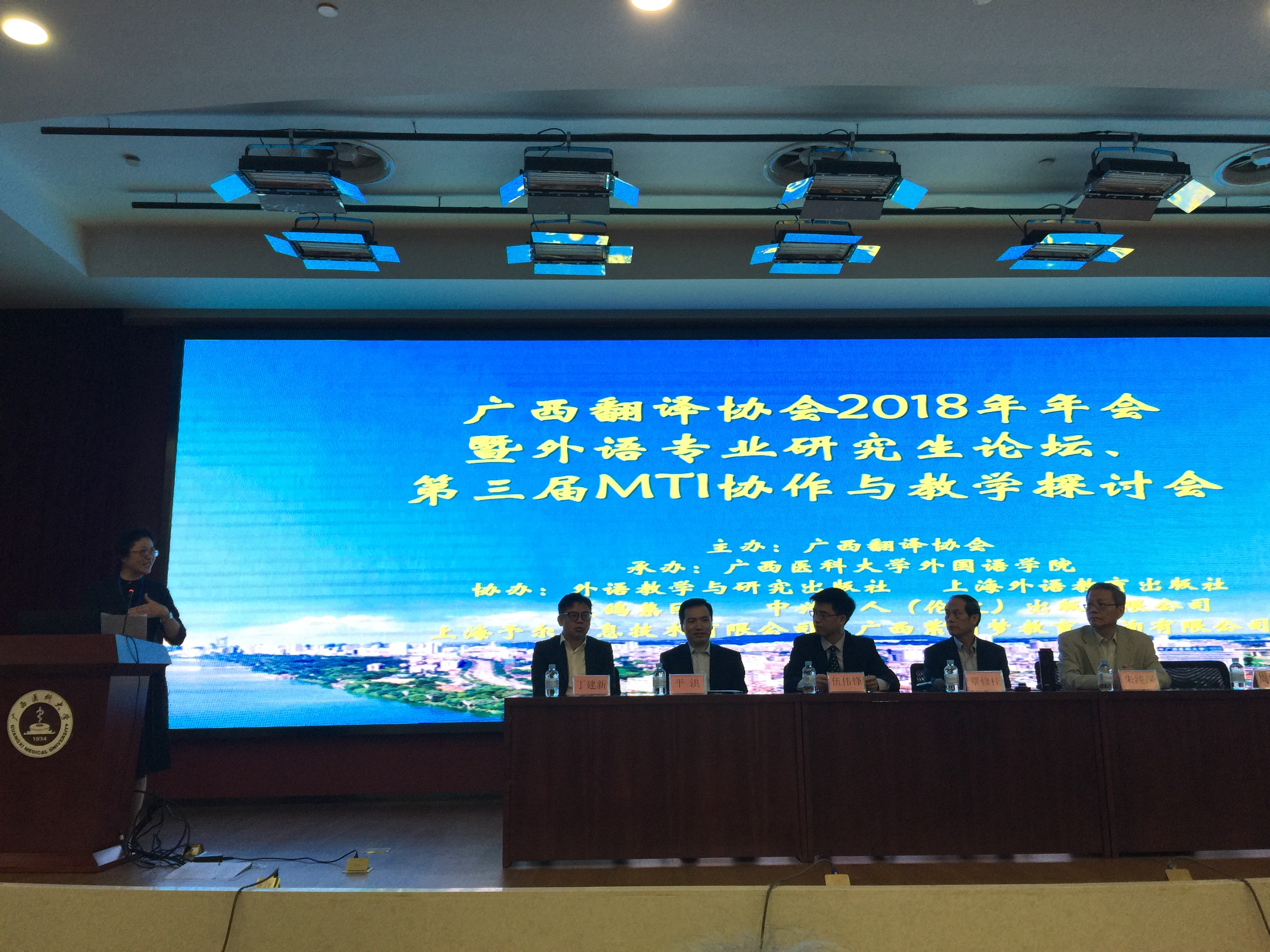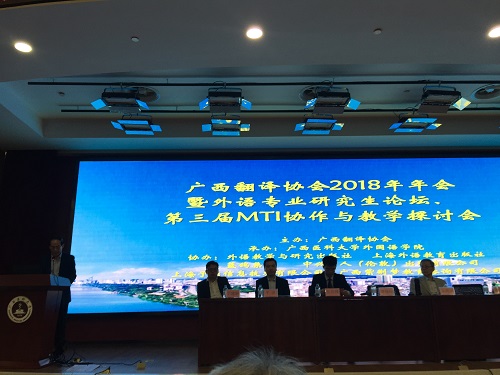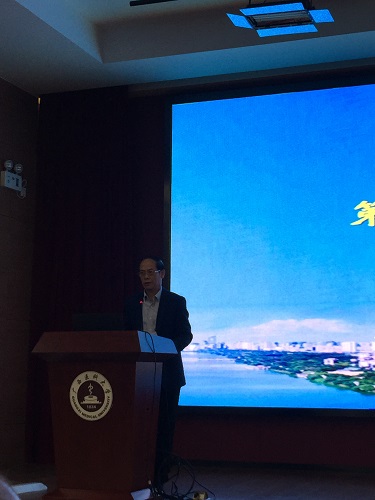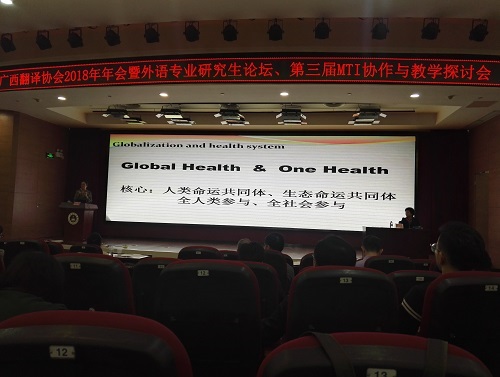戒骄戒躁,不断前进 ??“广西译协 2018 年年会暨外语专业研究生论坛、 第三届 MTI 协作与教学研讨会”闭幕辞
作者:刘绍忠 发布时间:2018-11-11 15:27:27


各位同行,各位同学: 为期一天半的“广西译协 2018 年年会暨外语专业研究生论坛、第三届 MTI 协作与教 学研讨会”,在会议组委会高节奏,高效率的组织安排下,在全体与会者的共同努力下, 各项议程已经完成,会议就要结束了。授协会常务理事会的委托,由我做个小结。其实, 刚才会长跟大家分享的这次会议的几个情况或亮点,以及各分组组长关于各分组的讨论情 况分享,等于已经对会议做过小结了。我借这个机会,说三点意见和看法。

一、又是一次成功的会议。我们在短短的一天半,聆听了 4 场主旨发言,9 场大会发 言,六组分组发言。很成功,很高效!会议有四个特点:第一个特点是,区内专家为主, 使得年会的平台,逐渐成为区内学者交流学问的主要平台之一。特点之二,学术性强,注 重学术引领。香港中文大学深圳校区的朱纯深教授对“信达雅”的深度重构,广东外语外 贸大学平洪教授对 MTI 内涵发展与专业建设的权威解读,上海师范大学朱振武教授关于文 学研究的比较意识和跨面视野,中山大学丁建新教授关于边缘话语研究的辅导讲座,还有 区内学者有关语言、翻译研究和教学的成果交流,例如广西大学祝远德教授关于“文化走 出去背景下的民族经典翻译”,广西民族大学覃修桂教授关于“隐喻投射动因的平衡模 式”,桂林电子科技大学韦汉教授关于 MTI 质量监控体系建设,广西科技大学张树德教授 关于英国研究生有效指导的原则、方法、途径,广西师范大学袁斌业教授关于“翻译权力 的再思考”,广西民族大学李学宁教授关于“系统功能语言学在自然语言处理中的知识表 示研究”,广西师范学院姚本标教授关于广西景点名称及公示语翻译问题的研究,桂林理 工大学朱建斌副教授关于“菜名翻译效果的眼动实证研究”,广西医科大教授张红霞教授 关于“当英语承载的医学走进汉语文化的中国”等发言,无不让人感到启发颇深,收获满 满。特点之三,突出了 MTI,服务了教学,服务了学生。特点之四,多层次的交流,有老 师有学生,有博士生有研究生还有少数本科生,有学校的有教研辅助单位和部门的,大家 平等交流,相互启发,学到了东西。

二、学会站在国际译学的高度来开展研究。时下,对翻译理论和实践感兴趣的人越来 越多,选择出来讨论的问题越来越多,讨论使用的视野、工具和方法越来越丰富。我们要 引导师生冷静思考,要从学术兴趣出发,要有问题意识,要根据研究日程表实施研究,不 2 要着急,不要忙乱和盲目上阵。这里,我愿意再次跟大家分享著名语用翻译家 Leo Hickey (2000)教授列出的问题或话题清单,供大家参考,切莫闭门谈学问做研究,切莫重复浪 费。Hickey 教授认为,下面几个是从国际译学界的角度和高度看,做研究时需要不断把握 的几个本体论话题:
1)译者是什么样的人?(What is a translator? What does it mean by saying soemone is a translator?) For as long as individuals have communicated with one another through the mediation of someone else, there has probably been a realization that mediators do something more complex and more interesting than simply substitute their own words, one by one, for the originals. Since the early 1950s (Nida, 1952), however, there has been an upsurge in serious studies of translation, both in its theoretical, historical, didactic and professional dimensions and in its practice at the point when translators do something in response to their own reading of a text and which leads to the production of a second text. In particular, it is now understood that translators do not simply ‘say’ in one language what somebody or some piece of writing has ‘said’ in another. (Hickey, 2000:1)
2)翻译是怎样发生的? Whatever translation is in its entirety, it seems to involve semiotic, linguistic, textual, lexical, social, sociological, cultural and psychological aspects or elements, all of which are being studied nowadays as determining factors in whatever the translator does. It is also becoming clear that, as in any other form of rewriting (Gentzler, 1993:ix; Lefevere, 1992), this implies manipulation and relates directly to ideology, power, value systems and perceptions of reality. (Hickey, 2000:1)
3)翻译的客体是什么? One of the many questions that recur, explicitly or implicitly, in these investigations is whether there is some objective entity, linguistic, semantic or psychological, expressed in or by an ‘original’, which can then be captured by a different text, the translation. In other words, is there something in, behind, underneath or belonging to a piece of writing in one language which can be extrapolated ad safely packaged in another? After all, at first sight, something seems to survive and pass more or less intact from one text to another in the process and the product of translation. (Hickey, 2000:1)
4) 翻译要译什么?(翻译可以省去什么?可以做到绝对对等吗?是要结构形式上的对等 还是功能上的对等?) What is it, then, if anything, that is actually translated, transferred, between one text and another? Is it some part, ingredient or linguistic element of the text itself, or is it something less direct about the text, such as a particular reader’s reaction or interpretation of it? 3 And what happens to those elements which are not transferred? Are they irrelevant, surplus to requirements, treated as of no importance and simply ignored? Is translation some kind of science, pure or applied, prescriptive or descriptive, or is it practical art or craft, which cannot be discussed until the event, analogously to a conversation about the beauty of a sunset or a bird in flight? If the notion that something remains unscathed in the process of translation is too extreme, then perhaps there may be aspects of the original and the translation which, if not identical, are at least equivalent to one another. For some time now, the notion of equivalence, or rather equivalences, has been debated with varying degrees of enthusiasm and conviction (Bassnett, 1991:23-9). It may also be that translation is merely an approximate, imprecise procedure, and that any text has so many dimensions that equivalence on one may be incompatible with equivalence on some others. For example, linguistic equivalence (an extreme case of which word be word-for-word translation) may conflict with dynamic equivalence (stimulating an effect in the reader of the translation similar to that caused in the reader of the original), in the sense that if the linguistic surface of both texts is similar, the effect on their readers may necessarily be very different, and vice versa. And does translation deal with what the original author intended or simply what is expressed by the text?
5)翻译学科应该怎么命名? Among the many approaches to research on translation which are yielding useful insights nowadays, Translation Studies has been in particular favor since the mid-1960s (Bassnett, 1996:6). Translation Studies concentrates on describing and analyzing the procedure or processes, rather than commenting on the product itself ad asking how well or badly any particular translation has been done. This non-prescriptive approach, among others, is interested in how translation is actually done, examining the methods that have been used throughout history and asking how texts fit into the receiving cultures. (Hickey, 2000:2) 取什么样的名字,就做什么样的事;MTI 师生,就要做、也必须是 master in translation and interpretation! 除了动手能力强,理论也要娴熟;不仅要做翻译实践,还要做翻译研究, 要知道怎么译,怎么译更好更有道理!
6)翻译应该怎么教?(翻译的教学目标、内容、方法、质量监控手段、评估验收理念与 工具) Much work is also being carried out on the teaching of translation, with or without some kind of theoretical or academic underpinning. Universities and similar institutions educate graduates who go on to earn their living as translators. Some courses use translation merely as methodological tool for language teaching, 4 without claiming to train translators, while others provide training in all aspects of the translator’s work including practice in registers, gathering and storing terminology, compiling data bases, documentation, IT etc. Closely related to teaching is assessment or evaluation, quality assurance or revision of translation, as part of the process itself or carried out on the product. It is done on various levels, from the practitioner’s own impressionistic assessment of a first draft or a teacher’s equally subjective, but perhaps more experience-based, comments on a student’s piece of work to more academic attempts to develop systematic methods for the evaluation of professional work (House, 1976). The profession of the translator, with its problems and practical considerations, is sporadically, though seldom systematically, treated in journals and newsletters. The practice of the profession under pressure, working to deadlines, satisfying different types of clients, using dictionaries of all kinds, whether monolingual or multilingual, general or technical, hard-copy or computer-based, by in-house or freelance practitioners, making use of expert or other informants (often the clients themselves) is occasionally discussed, usually on an anecdotic level. (Hickey, 2000:2-3)
7)翻译研究应该研究什么? Despite much research and even calls for general theories and systems to explain or describe the translation process (Bassnett, 1993:248), most work on the subject matter continues to address specific problems and individual elements or aspects of translation, including comparisons of brief texts with their originals. These studies range from the treatment of such detailed points as puns or culture-specific terms to advice on how to handle legal documents between systems which have neither terminology nor legal entities in common; they may rely on intuitive reactions to the ‘readability’ of a particular translation or on academic investigations of contrastive structural linguistics. The volume of work being done and the multiplicity of approaches used suggest that the study of translation is actively attempting to emerge from its infancy. (Hickey, 2000:3)
8)新兴学科与翻译的嫁接和关系处理。 To pragmaticians, translation is about ‘doing things with words’, after Austin’ (1962) work How to Do Things with Words. If we return to the question of whether there is something in an original text which is carried over in its translation, a pragmaticist might suggest that something does indeed survive the process, namely (at the very least) what is potentially done by or in the original text, since the translation has the capability. In general, pragmatic approaches attempts to explain translation ? procedure, process and product ? from the point of view what is (potentially) done by the original author in or by the 5 text, what is (potentially) done in the translation as a response to the original, how and why it is done in that way in that context. (Hickey, 2000:4) My contention then is that, just as the ST is capable of producing or likely to produce or stimulate one or more analogically related perlocutionary effects on its original readers, so also any TT must, in turn, be capable of producing ‘analogous’ rather than ‘similar’, allows for the fact that, just as not all ST readers or their contexts are the same, so also the TT readers may be quite different, and situated in different contexts, from any of the ST readers. (Hickey, 2000:219)
三、年会之所以开得成功,凝聚力协会常务理事们的心血,尤其是会长、副会长、秘 书长们的集体智慧,大家支持、理解和配合,是承办单位广西医科大外语学院周院长和她 的团队的直接努力的结果,也是会议协办方的支持的结果。谢谢你们!我们要继续发扬我 们良好的合作传统,在今后的发展道路上,继续互相支持,精诚合作!
四、两点建议:一是对协会举办年会的一点建议。可以考虑每年的年会,明确一个议 题,引导大家集中精力对之进行思考,这样发言可以更加集中些,讨论更加深刻些,收获 也就更大些。目前,我们的论域比较大,有理论、实践、教学、管理、交流、技术,方方 面面,实际上我们涉足都十分有限,理论视野也很有限。二是对我们的研究生和博士生的 建议。大家的发言都很积极、很踊跃和勇敢。你们是我们事业的未来。这个平台也是为你 们设计的。博士生,你们可以用来读书的时间最多、最集中,你们要敢于进入前沿,要立 志于引领!研究生们要多读经典和原著,要善于小题大做,要牢记做学问写文章必须有问 题导向,不要因为发言后被老师们提问和点评后就气馁,这样你们的收获就会更大、更直 接!总之,要戒骄戒躁,不断前进。

再次感谢会议承办单位对本届会议的重视和充分准备,感谢会务组师生们的辛勤付出 和高效工作,感谢各位院长们、MTI 项目负责人、MTI 导师们、MTI 同学们的支持。我们 明年再见!
参考文献
Austin, J. (1962). How to do things with words. Oxford: Clarendon Press. Baker, M. (1993). Corpus linguistics and transaltion studies: Implications and applications. In M.
Baker, G. Francis and E. Tognini-Bonelli (eds.), Text and technolgy: In honor of John Sinclair. Philadelphia/Amsterdma: John Benjamins.
Bassnett, S. (1991). Translation studies. London: Routledge.
Gentzler, E. (1993). Contemporary translation theories. London: Routledge.
Hickey, L. (2000). The pragmatics of translation. Shanghai: SFLEP. Reprinted from the 1998 verion by Clevedon: Multilingual Matters Ltd.
Nida, E. (1952). God’s word in man’s language. New York: Harper & Brothers.
House, J. (1976). A model for translation quality assessment. Tubingen: Gunter Narr.
Lefevere, A. (1992). Translating, rewriting, and the manipulation of literary fame. London: Routledge.
友情链接
 |
 |
 |
||||
| 百色学院外国语学院 | 广西财经学院商务外国语学院 | 广西大学外国语学院 | 广西广播电视大学 | 广西民族大学外国语学院 | 广西民族大学东南亚语言文化学院 | 广西师范大学国际文化教育学院 | 广西师范大学外国语学院 | 南宁师范大学外国语学院 | 广西外国语学院 | 广西医科大学外语学院 | 广西艺术学院国际教育学院 | 桂林理工大学外语学院 | 桂林旅游学院外国语学院 | 河池学院外国语学院 | 北部湾大学国际教育与外国语学院 | 梧州学院国际交流学院 | 右江民族医学院国际语言文化教育学院 | 玉林师范学院外国语学院 | ||||||
